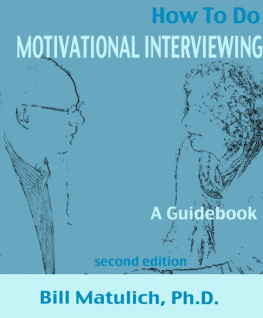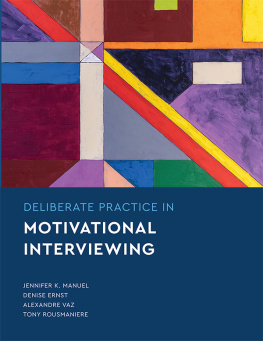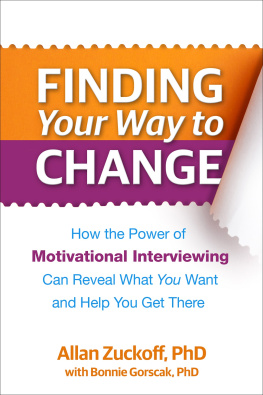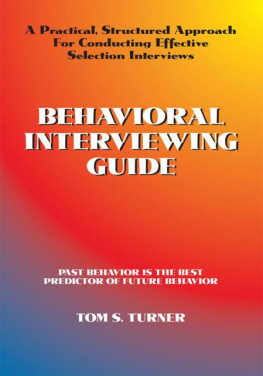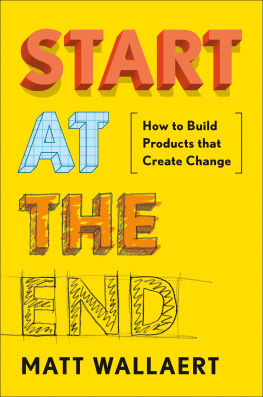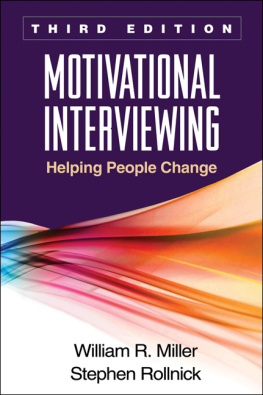How To Do MotivationalInterviewing: A Guidebook
nd edition
Bill Matulich, Ph.D.
Smashwords Edition
Copyright 2013 by Bill Matulich, Ph.D.
This ebook is licensed for your personal useonly. This ebook may not be re-sold or given away to other people.If you would like to share this book with another person, pleasepurchase an additional copy for each recipient. If you are readingthis book and did not purchase it, or it was not purchased for youruse only, then please return to Smashwords.com and purchase yourown copy. Thank you for respecting the hard work of thisauthor.
For permission to use material from this workcontact:
Bill Matulich, Ph.D.
billmatulich@mac.com
Website: www.motivationalinterviewingonline.com
Table of Contents
Introduction: How to usethis guidebook
You want to learn how to do MotivationalInterviewing (MI). You are not alone. As an effective,evidence-based counseling approach applicable to a wide range ofpsychological, behavioral and physical health issues, MI has becomea popular thing to learn. There are many ways to learn about MIincluding reading any of a number of wonderful books on the topic,taking a workshop or seminar and/or watching videos (there are evenvideos of people talking about and doing MI on YouTube). But evenin multi-day workshops, taught by the best workshop leaders, therejust isnt enough time to master the MI approach. Often, peopleleave a good training with the feeling that MI is hard to do and soare reluctant to try it with their clients, instead falling back onfamiliar but not necessarily MI consistent approaches.
While it is easy to learn the basics of MI,and many people have already learned the basic counseling skillsthat are used in MI before taking a workshop, applying the skillsand techniques strategically, as is done in MI, is more difficult.Learning and getting better at MI is really no different from anyother skill, like playing a musical instrument or juggling, in thatthese skills take practice.
So, while books, workshops and videos areall good, there is only one way to really learn how to do MI andthat is by trying it with your clients and letting your clientsteach you how to do it. This is how William Miller and StephenRollnick, the founders of MI, discovered and learned how to do MIthemselves. They have said, Our own clients have been our guides.And it is from them that we learned motivational interviewing.There are no better teachers. (Miller & Rollnick, 2002, pg.184) The purpose of this book, then, is to encourage you to learnMI the Miller and Rollnick way, by doing it and observing yourclients and letting them teach you.
Miller and Rollnick did not have theadvantages that you have. They did not have a completelyconceptualized approach with clearly identified principles,processes and practices. They later developed these so that youcould learn how to do MI. They did not have scientific evidence forthe effectiveness of what they were doing until they, and others,verified the approach through experimentation. In some sense theywere creating a roadmap for you to follow. When you take a trip,along with a roadmap, a guide might be helpful. That is what thisbook aims to accomplish: to be your guide on your journey oflearning how to do MI.
The purpose of this book, then, is to helpencourage you, especially if you have had some previous exposure toMI, to actually go do it and learn from your clients. MI itself isa guiding style of working with people and in the spirit of MI, Iam hoping that this book can be a guide for you to begin to usethis very powerful and effective approach. Once you begin to useMI, and begin to utilize the reactions and responses from yourclients as feedback, you are well on your way to improving yourskills.
The important elements that make up MI arenot new in that they have been present in other forms ofpsychotherapy, counseling, philosophical thinking and so forth forsome time. Unique to MI is how these elements are combined, thetiming of how theyre used, and their application in an effort toevoke change talk.(Rosengren, 2009, pg. 8) Likewise, all of thematerial in this book is available elsewhere. It is the way that Iam putting these pieces together that, I hope, is unique andhelpful, with the purpose of helping motivate you and give you theconfidence to actually begin to apply this approach with yourclients.
The reader of this book may notice what ismissing. I am not including a history of MI, a review of theevidence base for MI, or providing exercises for learning orimproving the basic skills of MI. This book is not meant to becomprehensive. There are also many psychological theories that I amneglecting here on purpose. Theories of motivation, ambivalence,change, communication, resistance and so on that underlie theprinciples and practices of MI can be found elsewhere, too.Instead, I am assuming that you are reading this because youalready have some basic counseling abilities, youve taken aworkshop or class in MI, or read some of the outstanding books thatare available to meet those needs. You already understand, or atleast have been exposed to, the history, the evidence and theusefulness of MI and now you want to do it. Youve seen or areaware of how simple techniques can be used skillfully to help yourclients change their behavior in healthy directions. But, maybe youare ambivalent about using MI in your practice. Maybe you are a bittentative about taking that first step and trying MI out with yourclients. Maybe youve tried some of the techniques with somesuccess and are now encouraged to do more and need a direction togo. Maybe you need a refresher. Whatever your reason for buyingthis book, I hope you find it to be useful.
The book is organized as if followingtypical MI sessions: preparation, beginning, middle, and end. Thereare reasons for how things are done in MI that need to be clarifiedso that it makes sense to do them in a particular way. So, I begineach section with a brief explanation and provide several examples.This is followed by what you might look for in your clientsresponses that tell you if you are doing it right. Each sectionends with a summary or check list of what you should strive toaccomplish during that particular part of the session.
All human conversations are organic,however, meaning that they are unpredictable and evolve their owndirection depending on you, your skills, the client, the clientsissues, the topic, the setting, etc. My examples are in no waymeant to be a script of words that you repeat verbatim. Nor is thisbook meant to be a manual. Hopefully, the brief explanations willpoint the way and the examples will show you what you might say ordo, but your own sessions will be determined by your attention toyour clients and your own personal style. So use this informationto your best advantage and adapt what you read here to your own wayof working with people. The bibliography at the end is annotatedand there are resources for more information and training, shouldyou so desire.
Comments about the second edition:
Since the publication of the first editionof this ebook in 2010, there have been some changes to the way wethink about, talk about and teach the concepts of MotivationalInterviewing. These changes have come about because of the ongoingresearch and other developments that have encouraged the evolutionof MI over time. The changes were significant enough that Drs.Miller and Rollnick have published the third edition of theirclassic book, Motivational Interviewing: Helping PeopleChange, just this year. As a result I've expanded this ebookslightly in an attempt to incorporate these changes withoutbecoming overly complex.
I have also added a glossary at the end ofthe book at the request and suggestion of readers, cleaned up thewriting and formatting a bit, added a more "professional" cover,and, as I've learned more about ebooks in general, made the tableof contents "clickable." I am hopeful that these improvements willmake the work more user friendly and enjoyable.
Next page
